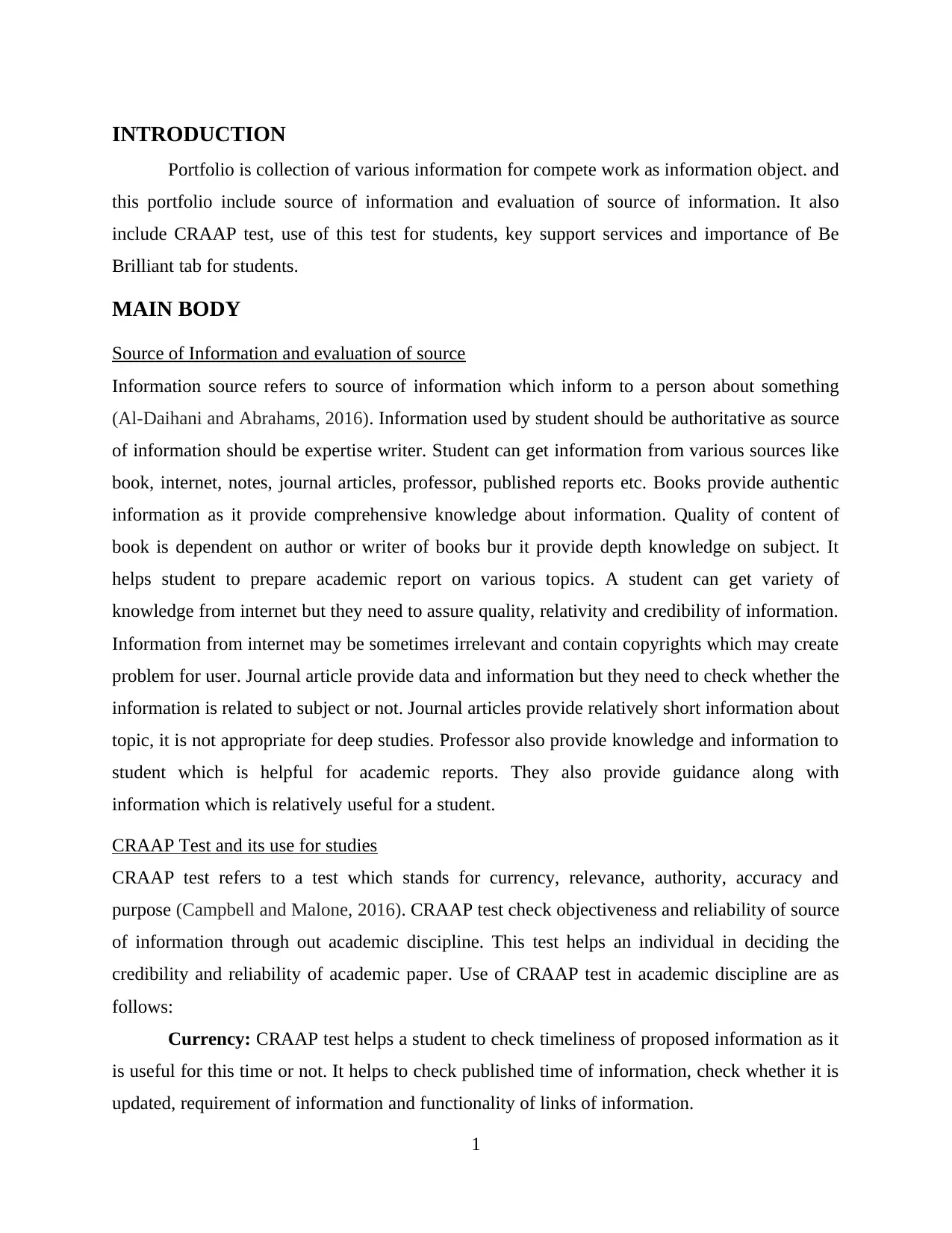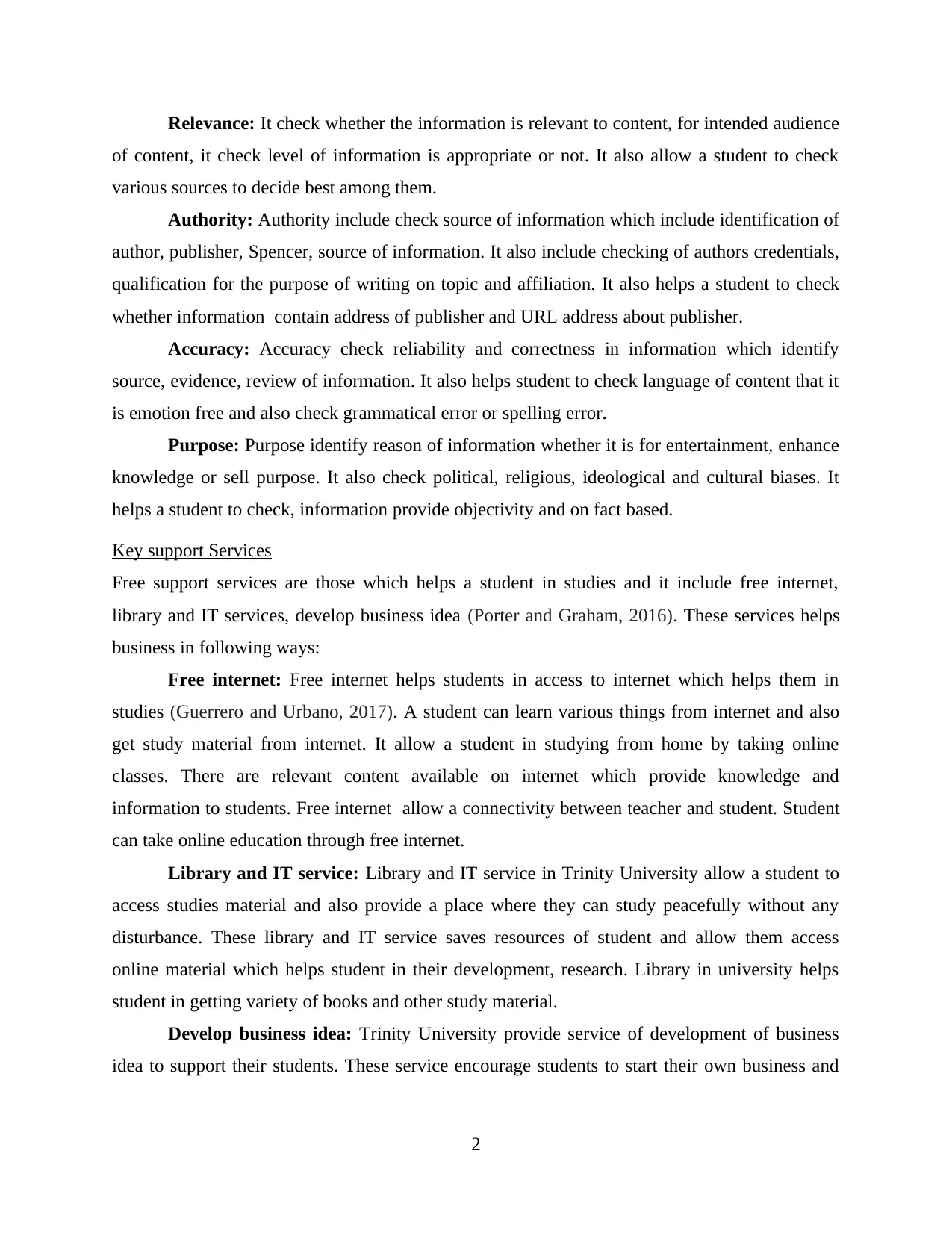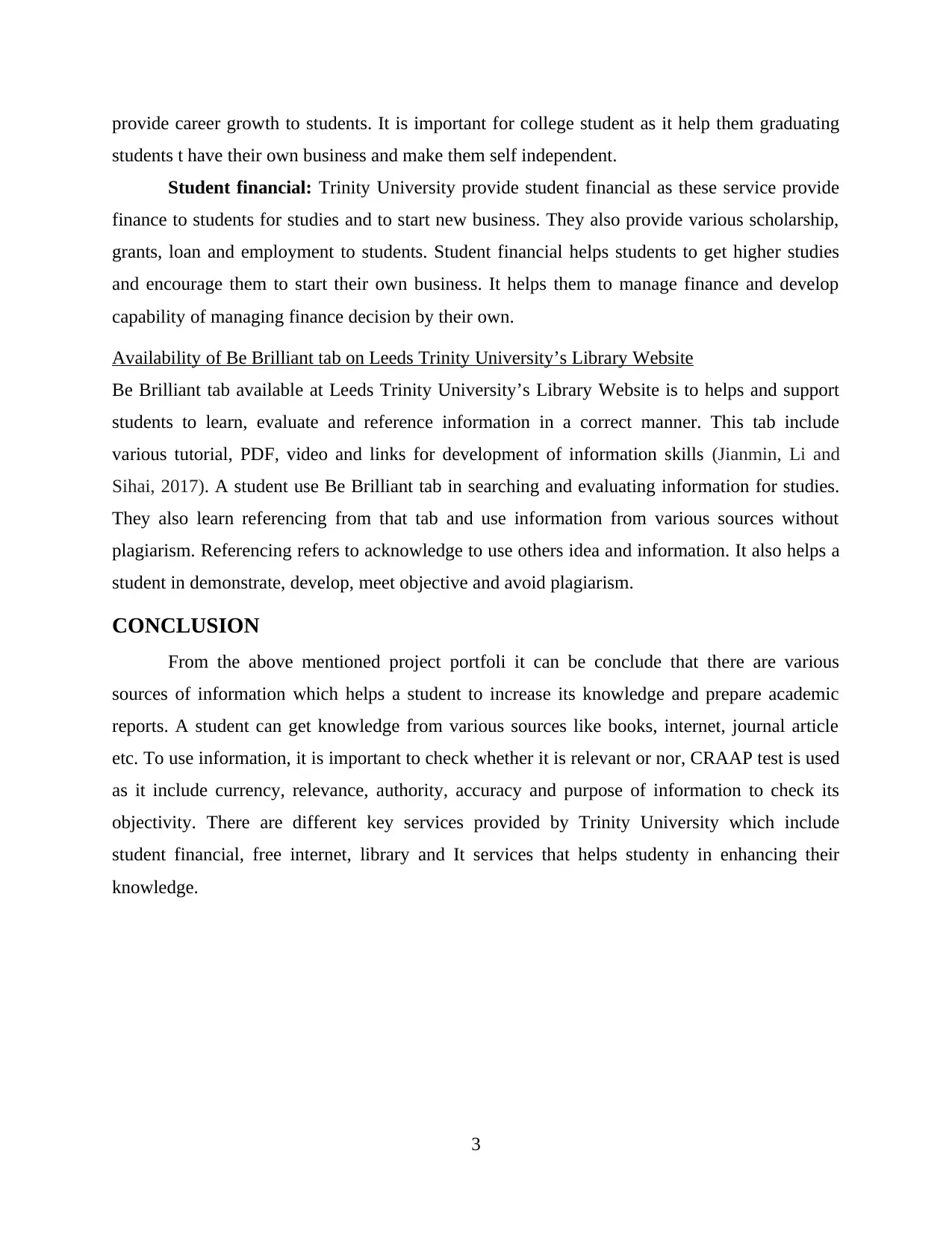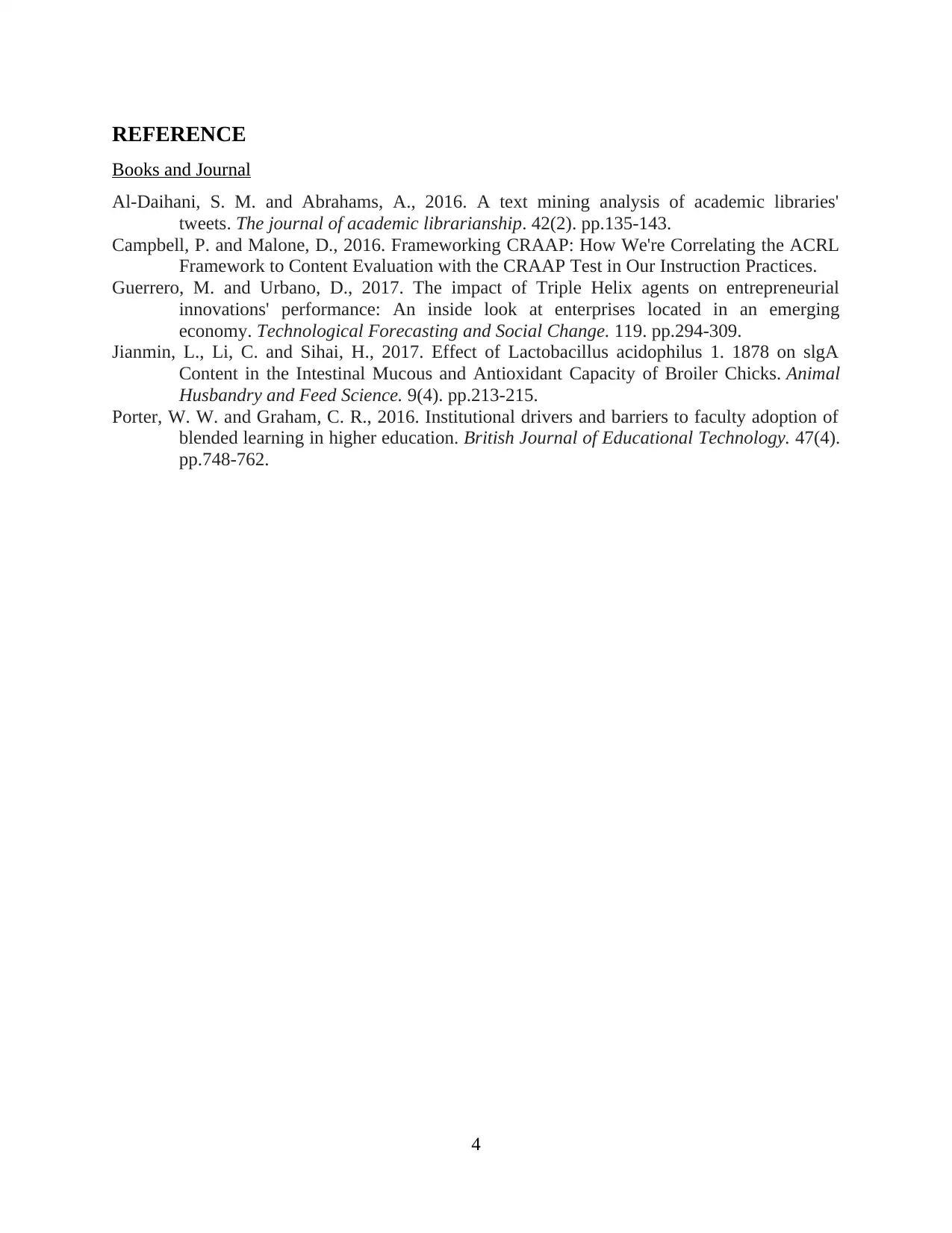Portfolio: Source Evaluation and Information in Higher Education
VerifiedAdded on 2022/12/26
|7
|1417
|88
Portfolio
AI Summary
This portfolio provides an in-depth analysis of information sources, evaluating their credibility and relevance. It explores various sources like books, internet resources, and journal articles, emphasizing the importance of authoritative information for academic work. The portfolio details the CRAAP test (Currency, Relevance, Authority, Accuracy, and Purpose) as a crucial tool for assessing the reliability of information. Furthermore, it highlights key support services offered by Leeds Trinity University, including free internet access, library and IT services, and student financial aid, underscoring their impact on student success. The role of the 'Be Brilliant' tab on the university's library website is also discussed, showcasing its resources for enhancing students' information literacy skills and preventing plagiarism. The portfolio concludes by summarizing the importance of these elements in fostering effective research and academic performance.

Portfolio
Paraphrase This Document
Need a fresh take? Get an instant paraphrase of this document with our AI Paraphraser

Table of Contents
INTRODUCTION...........................................................................................................................1
MAIN BODY...................................................................................................................................1
Source of Information and evaluation of source..........................................................................1
CRAAP Test and its use for studies.............................................................................................1
Key support Services...................................................................................................................2
Availability of Be Brilliant tab on Leeds Trinity University’s Library Website.........................3
CONCLUSION .............................................................................................................................3
REFERENCE...................................................................................................................................4
INTRODUCTION...........................................................................................................................1
MAIN BODY...................................................................................................................................1
Source of Information and evaluation of source..........................................................................1
CRAAP Test and its use for studies.............................................................................................1
Key support Services...................................................................................................................2
Availability of Be Brilliant tab on Leeds Trinity University’s Library Website.........................3
CONCLUSION .............................................................................................................................3
REFERENCE...................................................................................................................................4

⊘ This is a preview!⊘
Do you want full access?
Subscribe today to unlock all pages.

Trusted by 1+ million students worldwide

INTRODUCTION
Portfolio is collection of various information for compete work as information object. and
this portfolio include source of information and evaluation of source of information. It also
include CRAAP test, use of this test for students, key support services and importance of Be
Brilliant tab for students.
MAIN BODY
Source of Information and evaluation of source
Information source refers to source of information which inform to a person about something
(Al-Daihani and Abrahams, 2016). Information used by student should be authoritative as source
of information should be expertise writer. Student can get information from various sources like
book, internet, notes, journal articles, professor, published reports etc. Books provide authentic
information as it provide comprehensive knowledge about information. Quality of content of
book is dependent on author or writer of books bur it provide depth knowledge on subject. It
helps student to prepare academic report on various topics. A student can get variety of
knowledge from internet but they need to assure quality, relativity and credibility of information.
Information from internet may be sometimes irrelevant and contain copyrights which may create
problem for user. Journal article provide data and information but they need to check whether the
information is related to subject or not. Journal articles provide relatively short information about
topic, it is not appropriate for deep studies. Professor also provide knowledge and information to
student which is helpful for academic reports. They also provide guidance along with
information which is relatively useful for a student.
CRAAP Test and its use for studies
CRAAP test refers to a test which stands for currency, relevance, authority, accuracy and
purpose (Campbell and Malone, 2016). CRAAP test check objectiveness and reliability of source
of information through out academic discipline. This test helps an individual in deciding the
credibility and reliability of academic paper. Use of CRAAP test in academic discipline are as
follows:
Currency: CRAAP test helps a student to check timeliness of proposed information as it
is useful for this time or not. It helps to check published time of information, check whether it is
updated, requirement of information and functionality of links of information.
1
Portfolio is collection of various information for compete work as information object. and
this portfolio include source of information and evaluation of source of information. It also
include CRAAP test, use of this test for students, key support services and importance of Be
Brilliant tab for students.
MAIN BODY
Source of Information and evaluation of source
Information source refers to source of information which inform to a person about something
(Al-Daihani and Abrahams, 2016). Information used by student should be authoritative as source
of information should be expertise writer. Student can get information from various sources like
book, internet, notes, journal articles, professor, published reports etc. Books provide authentic
information as it provide comprehensive knowledge about information. Quality of content of
book is dependent on author or writer of books bur it provide depth knowledge on subject. It
helps student to prepare academic report on various topics. A student can get variety of
knowledge from internet but they need to assure quality, relativity and credibility of information.
Information from internet may be sometimes irrelevant and contain copyrights which may create
problem for user. Journal article provide data and information but they need to check whether the
information is related to subject or not. Journal articles provide relatively short information about
topic, it is not appropriate for deep studies. Professor also provide knowledge and information to
student which is helpful for academic reports. They also provide guidance along with
information which is relatively useful for a student.
CRAAP Test and its use for studies
CRAAP test refers to a test which stands for currency, relevance, authority, accuracy and
purpose (Campbell and Malone, 2016). CRAAP test check objectiveness and reliability of source
of information through out academic discipline. This test helps an individual in deciding the
credibility and reliability of academic paper. Use of CRAAP test in academic discipline are as
follows:
Currency: CRAAP test helps a student to check timeliness of proposed information as it
is useful for this time or not. It helps to check published time of information, check whether it is
updated, requirement of information and functionality of links of information.
1
Paraphrase This Document
Need a fresh take? Get an instant paraphrase of this document with our AI Paraphraser

Relevance: It check whether the information is relevant to content, for intended audience
of content, it check level of information is appropriate or not. It also allow a student to check
various sources to decide best among them.
Authority: Authority include check source of information which include identification of
author, publisher, Spencer, source of information. It also include checking of authors credentials,
qualification for the purpose of writing on topic and affiliation. It also helps a student to check
whether information contain address of publisher and URL address about publisher.
Accuracy: Accuracy check reliability and correctness in information which identify
source, evidence, review of information. It also helps student to check language of content that it
is emotion free and also check grammatical error or spelling error.
Purpose: Purpose identify reason of information whether it is for entertainment, enhance
knowledge or sell purpose. It also check political, religious, ideological and cultural biases. It
helps a student to check, information provide objectivity and on fact based.
Key support Services
Free support services are those which helps a student in studies and it include free internet,
library and IT services, develop business idea (Porter and Graham, 2016). These services helps
business in following ways:
Free internet: Free internet helps students in access to internet which helps them in
studies (Guerrero and Urbano, 2017). A student can learn various things from internet and also
get study material from internet. It allow a student in studying from home by taking online
classes. There are relevant content available on internet which provide knowledge and
information to students. Free internet allow a connectivity between teacher and student. Student
can take online education through free internet.
Library and IT service: Library and IT service in Trinity University allow a student to
access studies material and also provide a place where they can study peacefully without any
disturbance. These library and IT service saves resources of student and allow them access
online material which helps student in their development, research. Library in university helps
student in getting variety of books and other study material.
Develop business idea: Trinity University provide service of development of business
idea to support their students. These service encourage students to start their own business and
2
of content, it check level of information is appropriate or not. It also allow a student to check
various sources to decide best among them.
Authority: Authority include check source of information which include identification of
author, publisher, Spencer, source of information. It also include checking of authors credentials,
qualification for the purpose of writing on topic and affiliation. It also helps a student to check
whether information contain address of publisher and URL address about publisher.
Accuracy: Accuracy check reliability and correctness in information which identify
source, evidence, review of information. It also helps student to check language of content that it
is emotion free and also check grammatical error or spelling error.
Purpose: Purpose identify reason of information whether it is for entertainment, enhance
knowledge or sell purpose. It also check political, religious, ideological and cultural biases. It
helps a student to check, information provide objectivity and on fact based.
Key support Services
Free support services are those which helps a student in studies and it include free internet,
library and IT services, develop business idea (Porter and Graham, 2016). These services helps
business in following ways:
Free internet: Free internet helps students in access to internet which helps them in
studies (Guerrero and Urbano, 2017). A student can learn various things from internet and also
get study material from internet. It allow a student in studying from home by taking online
classes. There are relevant content available on internet which provide knowledge and
information to students. Free internet allow a connectivity between teacher and student. Student
can take online education through free internet.
Library and IT service: Library and IT service in Trinity University allow a student to
access studies material and also provide a place where they can study peacefully without any
disturbance. These library and IT service saves resources of student and allow them access
online material which helps student in their development, research. Library in university helps
student in getting variety of books and other study material.
Develop business idea: Trinity University provide service of development of business
idea to support their students. These service encourage students to start their own business and
2

provide career growth to students. It is important for college student as it help them graduating
students t have their own business and make them self independent.
Student financial: Trinity University provide student financial as these service provide
finance to students for studies and to start new business. They also provide various scholarship,
grants, loan and employment to students. Student financial helps students to get higher studies
and encourage them to start their own business. It helps them to manage finance and develop
capability of managing finance decision by their own.
Availability of Be Brilliant tab on Leeds Trinity University’s Library Website
Be Brilliant tab available at Leeds Trinity University’s Library Website is to helps and support
students to learn, evaluate and reference information in a correct manner. This tab include
various tutorial, PDF, video and links for development of information skills (Jianmin, Li and
Sihai, 2017). A student use Be Brilliant tab in searching and evaluating information for studies.
They also learn referencing from that tab and use information from various sources without
plagiarism. Referencing refers to acknowledge to use others idea and information. It also helps a
student in demonstrate, develop, meet objective and avoid plagiarism.
CONCLUSION
From the above mentioned project portfoli it can be conclude that there are various
sources of information which helps a student to increase its knowledge and prepare academic
reports. A student can get knowledge from various sources like books, internet, journal article
etc. To use information, it is important to check whether it is relevant or nor, CRAAP test is used
as it include currency, relevance, authority, accuracy and purpose of information to check its
objectivity. There are different key services provided by Trinity University which include
student financial, free internet, library and It services that helps studenty in enhancing their
knowledge.
3
students t have their own business and make them self independent.
Student financial: Trinity University provide student financial as these service provide
finance to students for studies and to start new business. They also provide various scholarship,
grants, loan and employment to students. Student financial helps students to get higher studies
and encourage them to start their own business. It helps them to manage finance and develop
capability of managing finance decision by their own.
Availability of Be Brilliant tab on Leeds Trinity University’s Library Website
Be Brilliant tab available at Leeds Trinity University’s Library Website is to helps and support
students to learn, evaluate and reference information in a correct manner. This tab include
various tutorial, PDF, video and links for development of information skills (Jianmin, Li and
Sihai, 2017). A student use Be Brilliant tab in searching and evaluating information for studies.
They also learn referencing from that tab and use information from various sources without
plagiarism. Referencing refers to acknowledge to use others idea and information. It also helps a
student in demonstrate, develop, meet objective and avoid plagiarism.
CONCLUSION
From the above mentioned project portfoli it can be conclude that there are various
sources of information which helps a student to increase its knowledge and prepare academic
reports. A student can get knowledge from various sources like books, internet, journal article
etc. To use information, it is important to check whether it is relevant or nor, CRAAP test is used
as it include currency, relevance, authority, accuracy and purpose of information to check its
objectivity. There are different key services provided by Trinity University which include
student financial, free internet, library and It services that helps studenty in enhancing their
knowledge.
3
⊘ This is a preview!⊘
Do you want full access?
Subscribe today to unlock all pages.

Trusted by 1+ million students worldwide

REFERENCE
Books and Journal
Al-Daihani, S. M. and Abrahams, A., 2016. A text mining analysis of academic libraries'
tweets. The journal of academic librarianship. 42(2). pp.135-143.
Campbell, P. and Malone, D., 2016. Frameworking CRAAP: How We're Correlating the ACRL
Framework to Content Evaluation with the CRAAP Test in Our Instruction Practices.
Guerrero, M. and Urbano, D., 2017. The impact of Triple Helix agents on entrepreneurial
innovations' performance: An inside look at enterprises located in an emerging
economy. Technological Forecasting and Social Change. 119. pp.294-309.
Jianmin, L., Li, C. and Sihai, H., 2017. Effect of Lactobacillus acidophilus 1. 1878 on slgA
Content in the Intestinal Mucous and Antioxidant Capacity of Broiler Chicks. Animal
Husbandry and Feed Science. 9(4). pp.213-215.
Porter, W. W. and Graham, C. R., 2016. Institutional drivers and barriers to faculty adoption of
blended learning in higher education. British Journal of Educational Technology. 47(4).
pp.748-762.
4
Books and Journal
Al-Daihani, S. M. and Abrahams, A., 2016. A text mining analysis of academic libraries'
tweets. The journal of academic librarianship. 42(2). pp.135-143.
Campbell, P. and Malone, D., 2016. Frameworking CRAAP: How We're Correlating the ACRL
Framework to Content Evaluation with the CRAAP Test in Our Instruction Practices.
Guerrero, M. and Urbano, D., 2017. The impact of Triple Helix agents on entrepreneurial
innovations' performance: An inside look at enterprises located in an emerging
economy. Technological Forecasting and Social Change. 119. pp.294-309.
Jianmin, L., Li, C. and Sihai, H., 2017. Effect of Lactobacillus acidophilus 1. 1878 on slgA
Content in the Intestinal Mucous and Antioxidant Capacity of Broiler Chicks. Animal
Husbandry and Feed Science. 9(4). pp.213-215.
Porter, W. W. and Graham, C. R., 2016. Institutional drivers and barriers to faculty adoption of
blended learning in higher education. British Journal of Educational Technology. 47(4).
pp.748-762.
4
1 out of 7
Related Documents
Your All-in-One AI-Powered Toolkit for Academic Success.
+13062052269
info@desklib.com
Available 24*7 on WhatsApp / Email
![[object Object]](/_next/static/media/star-bottom.7253800d.svg)
Unlock your academic potential
Copyright © 2020–2025 A2Z Services. All Rights Reserved. Developed and managed by ZUCOL.





